

Data Reveals The Worst Thing About Visiting Cultural Organizations. The primary dissatisfier among visitors to both exhibit AND performance-based cultural organizations is something we can fix.

What is the worst thing about a visit to a cultural organization? That’s the topic of today’s Know Your Own Bone Fast Facts video. The data is in and there’s a clear leader…by a long shot. Increasing visitation to cultural organizations comes down to mastering the relationship between two things: reputation and satisfaction. While both of these feed into one another and have a somewhat dependent relationship, reputation is primarily established offsite while satisfaction is established onsite within the walls of your organization. So, what’s the most dissatisfying thing about a visit to a cultural organization?
This includes various museums, science centers, botanic gardens, zoos, aquariums, and other types of visitor-serving entities that have ongoing hours of operation and display collections. Re-thinking Narrative Production in Museums through Digital Storytelling Workshops. The last couple blogpost we published focused on Revealing Queer, an exhibition currently on view at the Museum of Industry and History in Seattle, WA that was spearheaded by Queering the Museum (QTM) and relied on a community-based approach to curation (read: Part 1 and Part 2).

Today, we host Nicole Robert, Doctoral Candidate in Feminist Studies and Co-Founder of QTM. Nina Simon on Bridging and Beyond at the Santa Cruz Museum of Art & History. Recently, Nina Simon, the director of the Santa Cruz Museum of Art & History (MAH) and Museum 2.0 extraordinaire, joined me (Aletheia) in a conversation/interview about social bridging, the limits of social bridging, working with community service providers to best support participating communities, as well as anti-bias visitor education and changing museums through hiring practices.

I was thankful for the time Nina shared to talk and her thoughts on MAH’s recent work, challenges and triumphs. We began by speaking a bit about a couple of MAH’s local detractors and the difference between being all things to all people and consciously seeking to meet your public mandate by trying to welcome all communities to your museum. The conversation then turned to welcoming visitors via museum spaces, programming, reputation and relationships that a museum cultivates. The following are Nina’s reflections transcribed from the interview, however Nina, Rose and I edited extensively for length.
The Arts and Humanities Accessibility Checklist. Www.shapearts.org.uk/media/1228613/shape_understanding_disabled_people_as_audiences_2012-13.pdf. Museum Audience Insight: The Attendance Slide: A call-to-action. On Thursday, the National Endowment for the Arts released the latest round of the Survey for Public Participation in the Arts (SPPA), one of the most important pieces of research to come out this year.

For museums, declines in attendance - a trend that goes back decades - have only continued, confirming what we've been seeing in our analysis over the past few years. Museums are losing attendance on both measures of audience share and size. The Whatcom Museum Serves Homeless Adults and Families: Year 2. Last year, we interviewed Mary Jo Maute, Education Coordinator at the Whatcom Museum in Bellingham, WA regarding the museum’s participation in Whatcom County’s Project Homeless Connect(PHC).
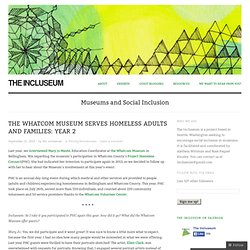
She had indicated her intention to participate again in 2013, so we decided to follow up with her to hear about the Museum’s involvement at this year’s event. PHC is an annual day-long event during which medical and other services are provided to people (adults and children) experiencing homelessness in Bellingham and Whatcom County. This year, PHC took place on July 26th, served more than 550 individuals, and counted about 220 community volunteers and 50 service providers thanks to the Whatcom Volunteer Center. Get Your Feet Wet With Visitor Surveys. What Was First The Chicken or The Egg? Last month, I attended the Open Culture 2013 conference and heard speakers from heritage organisations across the world discuss: How can collections management power the participatory museum of tomorrow?
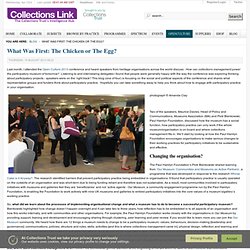
Peabody's Lament. The American Hysterical Society is the world’s first, largest, and only museum dedicated to collecting, creating, and curating comic and satirical perspectives on Clio and her misguided minions.
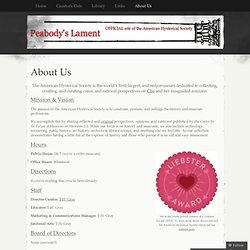
Mission & Vision The mission of the American Hysterical Society is to condemn, profane, and indulge the history and museum professions. We accomplish this by sharing collected and original perspectives, opinions, and rants not published by the Center for the Future of Museums or Museums 2.0. While our focus is on history and museums, we also include archeology, reenacting, public history, art history, archives & library science, and anything else we feel like. Rm6PHnRmdqqtGblgL*dz9cnUJ*eWTLoqOvhj7DNWYzqcRFb4BAGRrZxgUBiSqy202Qyt*CFJdUmvZJlsEHPskS0dE33/PHFOurMuseumEvaluationFrameworksummary.pdf. For Children With Autism, A Museum Can Be A Scary Place : Shots - Health News. Hide captionDylan Murphy, 3, plays with a swan at the Please Touch Museum in Philadelphia.
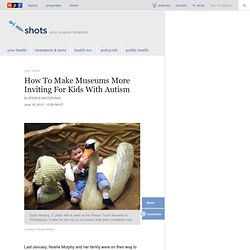
It was his first trip to a museum that didn't overwhelm him. AAM Online Seminar Room - Produced by LearningTimes_28. New Paradigms for Intercultural Work in Museums – or Intercultural Work as a New Paradigm for Museum Practice? Part II. Spotlight on Research–Subverting the Hetero-Normative Museum. One of our early goals with the Incluseum, was to provide a space where research and practice-based examples of social inclusion in museums could co-exist and, hopefully, inform each other.
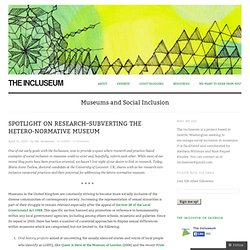
While most of our recent blog posts have been practice-oriented, we haven’t lost sight of our desire to link in research. Today, Maria Anna Tseliou, doctoral candidate at the University of Leicester, UK, shares with us her research into inclusive curatorial practices and their potential for addressing the hetero-normative museum. Museums in the United Kingdom are constantly striving to become more socially inclusive of the diverse communities of contemporary society. Increasing the representation of sexual minorities is part of their struggle to remain relevant especially after the appeal of Section 28 of the Local Government Act 1988. This specific section banned any promotion or reference to homosexuality within any local government agencies, including among others schools, museums and galleries. American Association for State and Local History.
By Chris Catanese & Kristie Smeltzer Collecting, analyzing, and sharing visitor comments effectively can be daunting when you are working with limited resources.
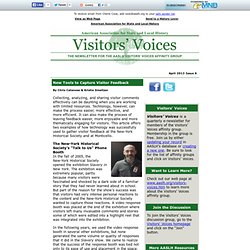
Technology, however, can make the process easier, more effective, and more efficient. It can also make the process of leaving feedback easier, more enjoyable and more thematically engaging for visitors. This article offers two examples of how technology was successfully used to gather visitor feedback at the New-York Historical Society and at Monticello. The New-York Historical Society's "Talk to Us" Phone Booth In the fall of 2005, the New-York Historical Society opened the exhibition Slavery in New York. Susan Kistler on BetterEvaluation and Eight Free Training Webinars. I am Susan Kistler, the American Evaluation Association’s Executive Director and aea365’s regular Saturday contributor.
Hot Tip – Collaboration with BetterEvaluation: Today, we’re excited to announce a partnership with BetterEvaluation. BetterEvaluation is an international collaboration to improve evaluation practice and theory by sharing information about options (methods or tools) and approaches. Why museums must start listening. I wonder how many of us feel a sense of belonging in a museum, a sense of promise about the ways our voices and heritage are connected to museum objects? As US arts guru Eric Booth writes: "Heritage reminds us that we belong; 'voice' offers the promise of what we can become ... an individual life that exhibits a balance between heritage and voice can be thought of as rich and empowered. " I believe in the power of museum objects to whisper stories and sometimes sing them.
I believe in objects and their stories as talismans that we pass from generation to generation – and museums as protectors of those stories, all of which help us understand who we are and our connections to the wider human family. In museums we place great weight upon our responsibilities as stewards of material heritage. Outside the Citadel, Social Practice Art Is Intended to Nurture. In New York an art organization that commissions public installations has been dispatching a journalist to politically precarious places around the world where she enlists artists and activists — often one and the same — to write for a Web site that can read more like a policy journal than an art portal. And in St. Louis an art institution known primarily for its monumental Richard Serra sculpture is turning itself into a hub of social activism, recently organizing a town-hall meeting where 350 people crowded in to talk about de facto segregation, one of the city’s most intractable problems.
If none of these projects sound much like art — or the art you are used to seeing in museums — that is precisely the point. As the commercial art world in America rides a boom unlike any it has ever experienced, another kind of art world growing rapidly in its shadows is beginning to assert itself. Enhancing Education: Evaluating Your Efforts. In today's increasingly businesslike world, with fewer dollars to go around, pure philanthropic giving is a thing of the past. Corporations, government agencies, and even foundations are taking a hard look at "Return on Investment" (ROI). Accessibility for Under 100 Dollars. Early Detection of Pairs of Visitors by Using a Museum Triage. Autism In the Museum. Museum – The Inclusion Issue : Full Spectrum. Addressing the Needs of Kids with Autism. Diversity Committee. The vision of the Diversity Professional Network (DIVCOM) is to create a vibrant and thriving museum community that reflects the dynamically diverse communities we serve at every level and requires active commitment to inclusion for every rating of excellence in museum practices, operation and reputation.
Museums as Community Advocates Part II « the incluseum. Finding a greater role for the people in public museums. Museum Audience Insight: Free Admission Days and Daily Deals. Free days. Visitor experience consulting. Archaeology, Museums & Outreach. Public Value: From Good Intentions to Public Good. For several years, I’ve been interested in public value as a framework for museums being more intentional about how they make a meaningful and recognized contribution to their communities. Recently several professional opportunities have focused on public value in museums.
The public value of visitor studies was the theme of the 2010 Visitor Studies Association conference in Phoenix. All 2010 issues of the Journal of Museum Education focused on museum education and public value. The Hermitage, Home of President Andrew Jackson. Www.thincdesign.com/pubarts/CuratorHennesDewey.pdf. Museum-Audiences-Primer - Home. Indoor Location Comes To The Royal BC Museum. VSA Massachusetts Blog - Help the Museum of Science Improve Exhibits!
August 11 - 21, 2012 Posted Tuesday August 07 2012 at 5:37 pm. Metrics and Evaluations. The J.